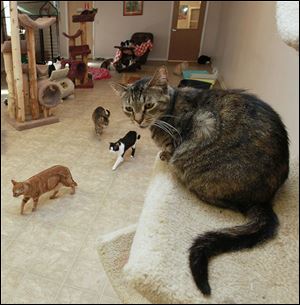
Cats inundate area adoption centers
Rescue groups look to deliver felines to good homes
8/15/2014
Lots of cats are available for adoption at the Maumee Valley Save-A-Pet in Toledo.
If Toledo-area residents have ever thought about adding a feline or two to the family, now is definitely the most opportune time.
Animal rescues are overloaded with hundreds of cats of all varieties. Shelters also have offered many adoption specials, making easy to adopt a pet.
Cats typically breed in warm weather, causing a spike in feline populations each summer during what is known as “kitten season.” Rescue groups take in hundreds of cats, straining resources and increasing work loads for staff and volunteers.
“We’re all struggling,” Karen Latta, cat coordinator for Planned Pethood, said. “It’s always horrendous and stressful in the summer.”
Planned Pethood has 145 cats in its foster-based program now. As soon as a spot opens, it is quickly refilled.
“We can only take in what we have space for,” Ms. Latta said. “We’re getting easily 200 calls a week for cats and kittens.”
Maumee Valley Save-A-Pet in Toledo is similarly packed with about 100 felines, which President Lori Friedes said is about double the maximum the shelter usually likes to maintain.
“We’re turning people down every day,” she said. “And it seems like every other day, there’s a box or carrier left at our door overnight.”
Many of the cats are pregnant, injured, or sick.
“That really breaks your budget,” Mrs. Friedes said. “We’re all doing the best we can with limited space and funds and volunteers.”
Paws and Whiskers Cat Shelter in Toledo has had to keep its population down because of ringworm and a scare with an outbreak of feline panleukopenia virus that closed the shelter for a week in June. The shelter currently has 81 felines and 17 more in foster care, with more than a 100 on a waiting list that started in November.
“We get anywhere from 30 to 40 calls a day,” Kim Ferguson, kennel supervisor, said. “And that’s not including what’s on the answering machine.”
The Toledo Area Humane Society in Maumee, the only open-admissions shelter for cats in Lucas County, has more than 240 cats up for adoption, in foster care, or in holding at the shelter. Adoption specials have helped; the rescue had as many as 384 felines just a few weeks ago.
“It turns into a full-time job just to coordinate it all,” Executive Director Gary Willoughby said. “There are a lot of moving parts to make sure everyone has what they need.”
Complicating matters for the humane society is its role as the county’s humane law enforcement agency. In recent months, the shelter has dealt with several large-scale seizures that have further stretched resources.
“There’s never a good time to take in 40 or 50 of anything, but it’s just more compounded in the summertime when we have so many cats and kittens,” Mr. Willoughby said.
Each of the rescue organizations stresses spaying and neutering as the most effective way to prevent unwanted litters and control the feline population. The Toledo-area’s low-cost spay and neuter clinic, Humane Ohio, has fixed more than 61,000 cats since it opened in 2006.
“We’re seeing a lot of demand, and that’s great,” Director Aimee St. Arnaud said. “That means a lot of people are wanting to get involved to solve the problem.”
The organization has spayed 3,561 cats so far in 2014, preventing an estimated 42,732 kittens if each female had two litters of six. Humane Ohio has spayed 35,090 cats since 2006, preventing 421,080 kittens, and expects spaying or neutering a total of 9,000 felines this year.
“We’ve been seeing the shelters dealing with this year after year,” Ms. St. Arnaud said. “That’s why prevention is so important. ... With our resources, we can help and our goal is really to focus on getting those numbers down.”
Animal-welfare organizations are working together to find space for incoming cats, relieve overcrowding in shelters, provide spay and neuter assistance to residents, and boost adoptions with joint promotions.
“We’re all trying to help each other,” Mr. Willoughby said. “Nothing we do is in a vacuum, and we all have the same goal.”
Contact Alexandra Mester: amester@theblade.com, 419-724-6066, or on Twitter @AlexMesterBlade.